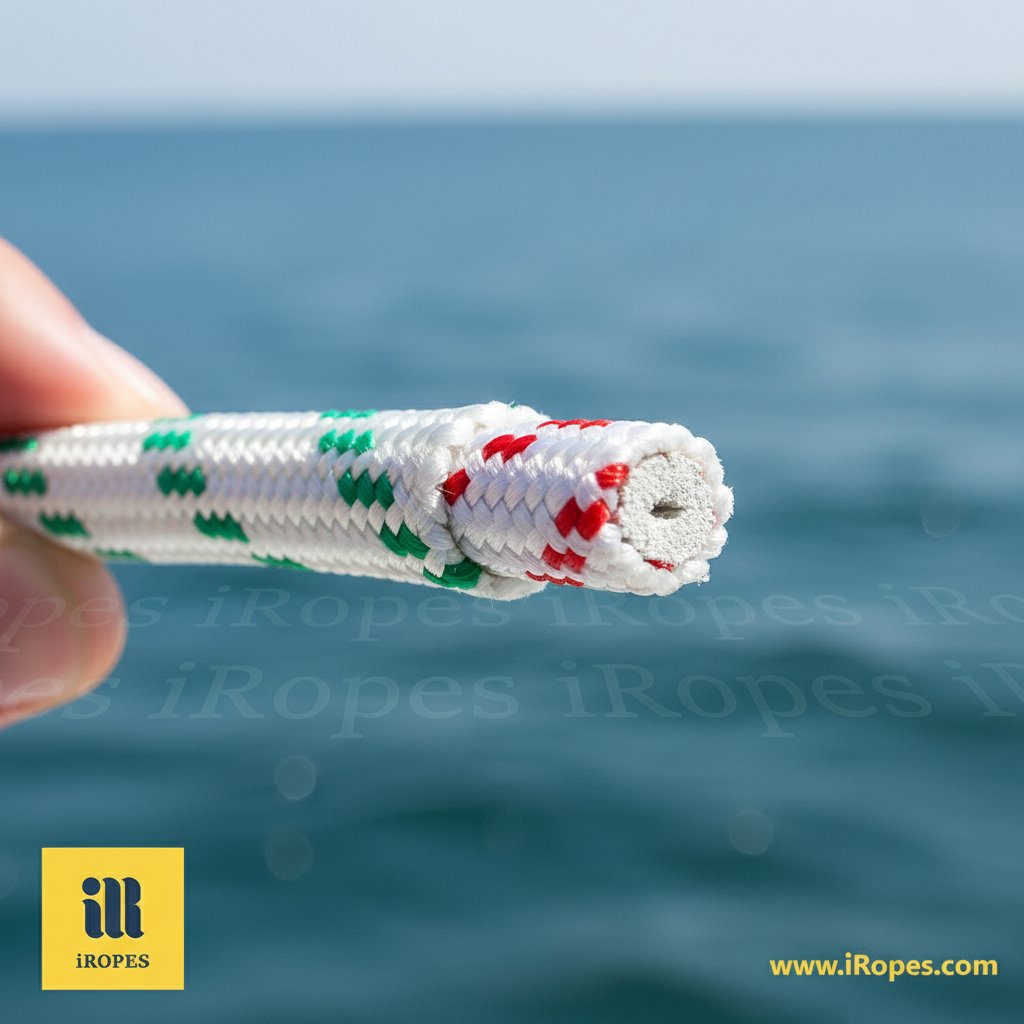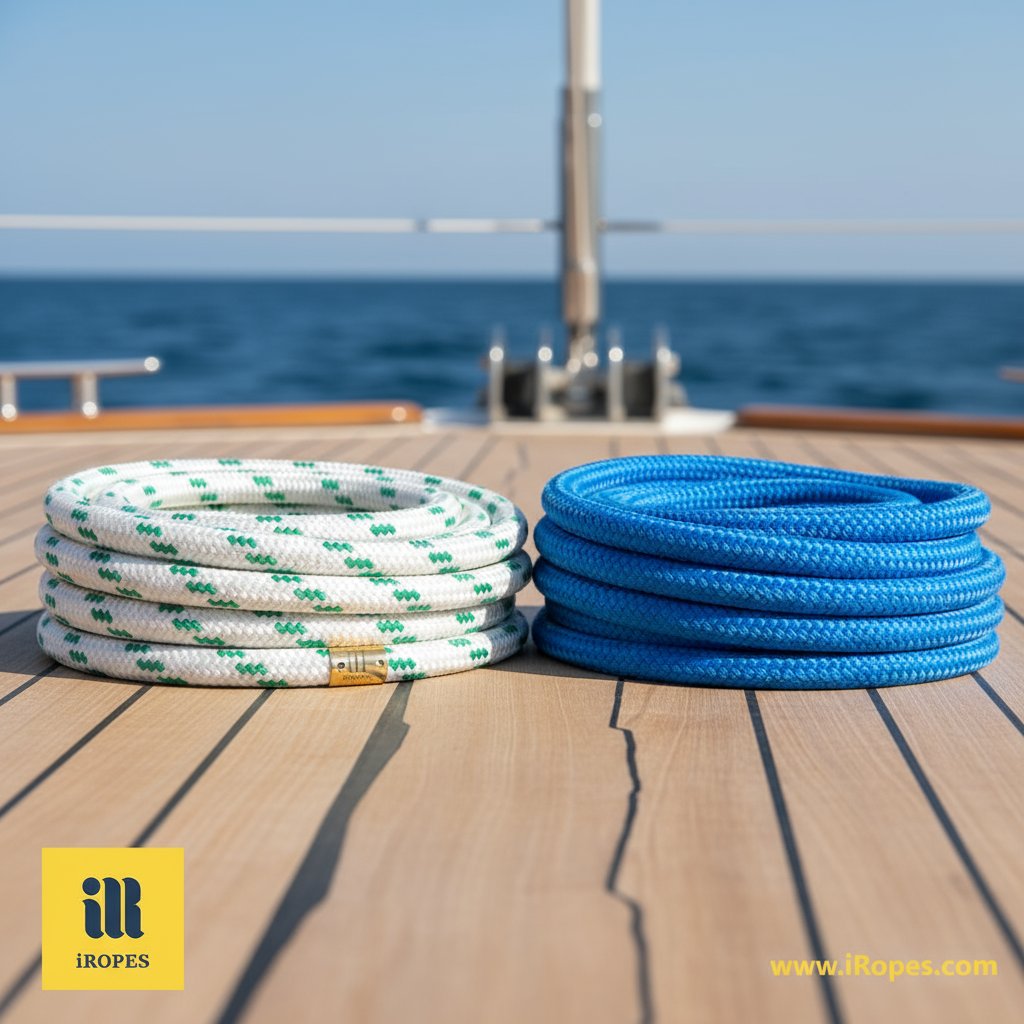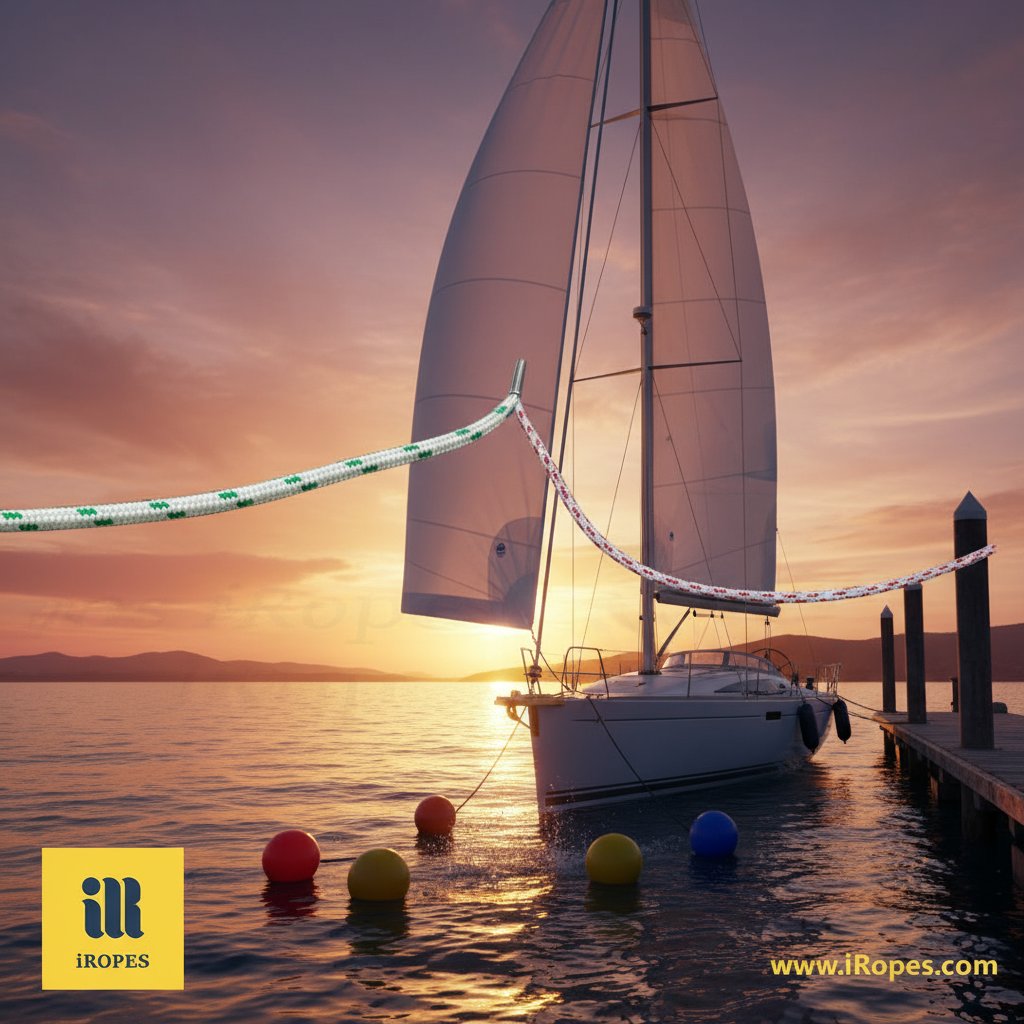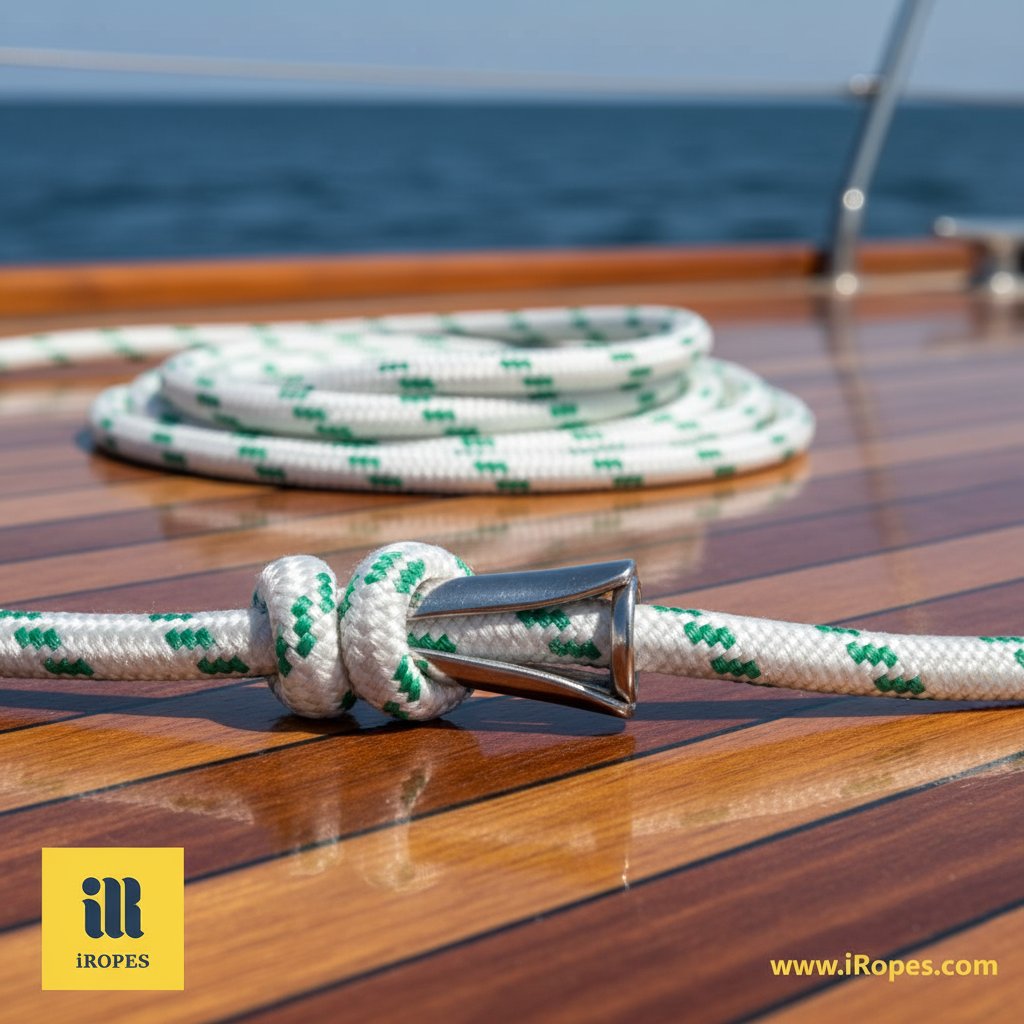Master elite yacht handling with double braid rope's splice secrets: achieve connections retaining 95% of full strength—far surpassing knots that cut capacity by 20-50%. This torque-free design eliminates kinking for seamless marine performance.
Discover yacht rope mastery in a 7-minute read →
- ✓ Gain torque-free insights on braid-on-braid construction, boosting strength-to-diameter ratio by 30% over twisted ropes for precise rigging control.
- ✓ Compare polyester's 15-20% low stretch vs. nylon's 40% shock absorption, solving material confusion for dock lines and halyards alike.
- ✓ Unlock splicing techniques retaining 95% strength, acquiring skills to create cleaner, snag-free eyes that extend rope life by years.
- ✓ Explore applications from yacht sheets to anchoring, with iRopes' ISO-certified customisation ensuring tailored solutions for your vessel's demands.
You might think knots suffice for yacht ropes. However, maritime professionals often avoid them. Why? Knots significantly weaken lines under load, potentially losing up to 50% of a rope's strength in high-stakes marine situations. What if splices could create robust connections, retaining 95% of a rope's power, transforming clunky handling into fluid precision? Dive in to uncover the secrets that make double braid yacht rope your ultimate advantage before your next voyage truly tests the limits.
Braid-on-Braid Rope: The Foundation of Double Braid Construction
Imagine being out on the water, your yacht effortlessly cutting through waves, every line responding with exacting precision—no twists, no fuss. This seamless experience is often due to the magic of braid-on-braid rope. At its core, this double braid yacht rope features a braided inner core enveloped by a braided outer sheath. This design creates a balanced, torque-free structure that distributes loads evenly. Consequently, it delivers a high strength-to-diameter ratio, providing robust performance without bulky ropes cluttering your deck. It's little wonder that seasoned sailors consistently choose it for demanding marine applications.
So, what exactly defines double braid rope? Picture the inner core as the rope's muscle, braided tightly for strength and flexibility. The outer sheath, on the other hand, acts like a smooth protective jacket, shielding the core and making handling easier. This innovative construction effectively eliminates hockling—those annoying loops that often form in twisted ropes under tension—and prevents kinking during regular use. The outcome is a rope that offers exceptional flexibility, coils neatly, and splices with remarkable ease, ultimately saving you time during repairs or rigging setups. Have you ever struggled with a stubborn knot that reduces your line's integrity? Braid-on-braid construction avoids such issues, maintaining the reliability of your rigging.
- Flexibility for smooth operation – Bends easily around winches and blocks without binding.
- No hockling or kinking – Stays straight under tension, reducing wear on hardware.
- Ease of splicing – Allows clean, robust connections that retain nearly full strength.
These characteristics truly excel in marine environments. The balanced load distribution ensures stress spreads evenly, which significantly enhances the rope's longevity, particularly when exposed to saltwater and harsh UV radiation. Moreover, its sleek, uniform appearance perfectly complements the polished aesthetic of yacht rigging—think sharp, white lines contrasting against elegant teak rails. I recall assisting a friend with rigging his sloop; upgrading to braid-on-braid transformed how the sheets ran, making adjustments feel effortless and precise.
Compared to traditional 3-strand ropes, which rely on twisting and can spin under load, double braided marine rope delivers superior handling for high-performance applications. While those older styles are adequate for basic tasks, they often hockle and feel stiffer, potentially leading to fatigue during long sails. Braid-on-braid, conversely, prioritises control and comfort, which is crucial when precision is paramount.

Understanding these fundamental aspects enables you to choose materials that precisely meet your yacht's demands. Whether you need minimal stretch for high-wind conditions or optimal shock absorption for choppy seas, the right material choice makes a significant difference.
Double Braid Yacht Rope: Material Options and Performance Properties
Building on the robust foundation of braid-on-braid construction, the material selection for your double braid yacht rope becomes the true differentiator. Different fibres offer unique performance traits, perfectly suiting various sailing conditions—from steady breezes to rough swells. Let's delve into the two most prevalent options: polyester and nylon. Each material excels in specific areas, contributing to your yacht's safety and responsiveness.
Consider polyester double braid yacht rope. This material is renowned for its low stretch, typically exhibiting only 15-20% elongation under load. This means your lines remain taut without excessive sagging when the wind intensifies. Polyester is also highly resilient against the relentless UV rays encountered offshore, and its abrasion resistance is excellent, proving invaluable when lines rub against hardware or docks. It's truly the dependable choice for halyards and control lines, where pinpoint precision is essential for trimming sails without losing efficiency. I've observed crews on extended passages who rely heavily on polyester because it maintains tension, reducing the constant adjustments that can lead to fatigue.
Polyester Double Braid
Low-Stretch Precision
UV Resistance
Retains strength for years under intense sun exposure.
Abrasion Toughness
Handles friction from winches and cleats without fraying quickly.
Tensile Strength
Between 1,800 to 12,000 lbs depending on diameter, ideal for steady loads.
Nylon Double Braid
Shock-Absorbing Elasticity
High Stretch
Up to 40% elongation, cushioning sudden jolts from waves.
Shock Absorption
Protects cleats and hulls during docking in choppy water.
Tensile Strength
Between 1,800 to 20,000 lbs depending on diameter, with added give.
Conversely, nylon double braid yacht rope excels with its impressive elasticity, stretching up to 40% to absorb shocks from waves or sudden wind gusts. This characteristic makes it an ideal choice for dock lines and anchor rodes, as a sudden pull could otherwise damage your boat's fittings. While nylon offers substantial tensile strength, its primary advantage lies in mitigating unexpected loads—picture tying up in a storm, where the rope yields just enough to prevent snapping. What distinguishes nylon from polyester? The critical difference lies in their responses to applied force: polyester minimises movement for control-focused tasks like sheets, maintaining low elongation to keep sails trim. Nylon, however, provides a vital buffer in dynamic scenarios due to its higher stretch, though it might require more frequent inspections for wear. Both materials boast tensile strengths in the thousands of pounds, depending on diameter. Yet, polyester generally offers superior UV and abrasion longevity, while nylon excels in impact resilience.
At iRopes, we ensure the quality of our double braided marine ropes with ISO 9001 certification and adherence to strict Cordage Institute standards. This commitment ensures every batch undergoes rigorous testing for consistency and safety. Our state-of-the-art facilities guarantee you receive ropes that perform reliably, regardless of the sea's unpredictable moods. How might selecting the optimal material transform your next marine excursion?

With these material insights, it becomes clear how different double braid options effectively adapt to various roles on your vessel, from rigging to mooring, thereby enhancing both safety and operational ease.
Applications of Double Braided Marine Rope in Yachting and Beyond
Having explored material choices, let's now envision how double braided marine rope performs in real-world scenarios on the water. Whether you're meticulously fine-tuning your yacht's setup or securing it against the changing tide, these ropes adapt seamlessly, transforming potential challenges into smooth operations. Let's delve into their primary applications, beginning with the core of yachting: a vessel’s rigging.
For yacht rigging, low-stretch polyester versions are indispensable for halyards, sheets, and travellers. These lines demand unwavering control—imagine hoisting a sail in a brisk wind, where even slight give could compromise your course. Polyester's minimal elongation keeps everything taut, allowing you to make adjustments with confidence and without constant tweaks. I once observed a skipper during a regatta replace older lines with this setup; the transformation was remarkable, with sheets gliding effortlessly through blocks, providing a distinct performance advantage.
Turning to docking, mooring, and anchoring, nylon double braided marine rope proves to be your most reliable ally for absorbing shocks. What are the best uses for double braid yacht rope? They are perfect precisely where waves or boats jostling against a dock require resilience. Nylon's elasticity cushions sudden jerks, protecting your cleats and hull from damage—effectively acting as a built-in bumper for unpredictable conditions. For more on these double braid nylon dock line solutions, explore how they enhance mooring safety. For anchor rodes, this stretch helps maintain grip without snapping under tidal pulls, making it ideal for overnight stays in busy harbours. Have you ever been tied up in a squall and felt that reassuring give? That's nylon working, prioritising safety over rigid resistance.
Anchoring
Nylon absorbs wave impacts to secure holds firmly.
Mooring
Handles tidal shifts without stressing fittings.
Halyards
Polyester ensures sails rise true and stay set.
Sheets
Low stretch for sharp, responsive maneuvers.
How strong is double braided marine rope? Its strength varies significantly by diameter and material, yet these lines consistently deliver substantial power for their size. For example, a 3/8-inch polyester version might have a breaking strength of approximately 3,200 pounds, with a safe working load (SWL) around 640 pounds—which is ample for most mid-sized yachts. Stepping up to 5/8-inch nylon, you could expect a 12,000-pound breaking strength, safely handling 2,400 pounds in dynamic loads. These metrics are derived from rigorous testing standards, ensuring their reliability in critical scenarios. Always select the appropriate diameter to match your boat's specifications and prevent potential overloads.
- 3/8-inch: 3,200 lbs breaking, 640 lbs SWL for light rigging.
- 1/2-inch: 5,400 lbs breaking, 1,080 lbs SWL for standard sheets.
- 5/8-inch: 12,000 lbs breaking, 2,400 lbs SWL for heavy anchoring.
Beyond yachting, double braid rope excels in diverse fields: spearfishing relies on it for robust gear tethers, defence applications benefit from its tough, low-profile characteristics, and various industrial tasks, such as towing, leverage its strength. At iRopes, we precisely customise these ropes for your specific needs—adjusting diameters or integrating thimbles to fit specialised gear—thereby maintaining peak performance across all applications.

These applications underscore why achieving correct connections is equally vital, particularly when loads rigorously test every fibre of the rope.
Splice Secrets for Elite Handling with Double Braid Yacht Rope
The applications we've just highlighted demonstrate how double braided marine rope propels your yacht through everything from rigging to anchoring. However, the ultimate performance test lies in how you join and secure it. This is where splicing becomes critical, transforming a simple length of rope into a tailored tool that consistently outperforms knots. If you've ever wondered, "Can you splice double braid rope?" The answer is unequivocally yes—its flexible construction makes the process straightforward, and the enhanced results are well worth the effort.
Splicing double braid yacht rope creates connections that are not only stronger, retaining up to 95% of the rope's full strength, but also significantly sleeker and more streamlined than bulky knots. Knots, by contrast, can reduce load capacity by 20-50% and are prone to snagging on hardware. A properly executed splice, however, glides smoothly through blocks and winches, thereby reducing wear and minimising hassle, especially during long days at sea. The braid-on-braid design plays a pivotal role here: the separate core and cover allow for independent manipulation, ensuring the join remains balanced and torque-free. Picture this scenario: I once observed a mate struggling with knots on his genoa sheet during a race until he learned to splice—afterward, his yacht handled flawlessly, with no drag or sudden slips.
Let's delve into the fundamentals of an eye splice, a common and essential technique for creating loops in braid-on-braid rope. This method integrates both the core and cover to form a secure eye without compromising the rope's integrity. You'll need specialised fid tools—needle-like helpers—to pull sections through, along with sharp scissors for precise cuts. Begin by measuring twice the desired eye size from the rope's end, then unlay the cover back to that point to expose the core. Gently "milk" the cover to loosen it, insert the fid into the core's throat, and pull the cover's tail through, burying it neatly. Next, taper and insert the core's end back into itself using the fid, staggering the entry point to avoid creating weak spots. Finally, smooth everything out, roll it underfoot to achieve a tight fit, and trim any excesses. When executed correctly, this splice holds firm under pressure, making it ideal for attaching blocks or thimbles. For advanced splicing techniques like plait to chain, these methods ensure even greater retention of strength in marine setups.
- Unlay the cover to expose the core at the measured point.
- Use a fid to bury the cover tail into the core, pulling it through smoothly.
- Taper and insert the core end back into the main body for full integration.
At iRopes, we simplify this process by offering pre-spliced ends on our double braid yacht ropes, complete with fitted thimbles for reinforced eyes or chafe guards to protect against rubbing. Our OEM and ODM services allow you to brand these products with your logo, customise lengths and diameters, and even add reflective strips for enhanced night visibility—all meticulously crafted by our skilled team to meet your exact specifications. Whether you are outfitting a fleet or prototyping a new line, these options ensure your gear arrives ready for immediate deployment.
To ensure your splices continue performing optimally against the sun's glare, salty spray, and constant friction, regular inspections are crucial. Examine them for frays or discolouration every few months, rinsing with fresh water after use to flush out grit. Tools such as a marlinspike can assist with re-taping, while storing coils loosely prevents creases that can weaken joins over time.
- Visual scan for wear – Look for loose strands or stiffness indicating UV damage.
- Gentle cleaning routine – Soak in mild soap to remove salt buildup without harsh chemicals.
- Secure storage – Hang or coil in shade to avoid heat that accelerates abrasion.
Adopting these habits will significantly extend your rope's lifespan, ensuring that every splice consistently supports the elite performance you expect from marine-grade lines.

Mastering braid-on-braid rope truly unlocks elite handling for yachting, with its torque-free construction delivering unmatched strength, flexibility, and ease of use in diverse marine environments. Whether you opt for low-stretch polyester double braid yacht rope for precise rigging like halyards and sheets, or elastic nylon for shock-absorbing dock lines and anchors, these ropes consistently ensure safety and performance under demanding conditions. Splicing techniques preserve nearly full strength, while iRopes' ISO 9001-certified customisation—tailoring materials, diameters, and pre-spliced ends—empowers wholesalers to meet highly specific needs, spanning from yacht applications to industrial uses beyond. To source the best yachting rope suppliers, consider partners like iRopes for premium, customizable options.
These insights underscore how selecting the appropriate double braided marine rope significantly elevates your operations, seamlessly combining durability against UV exposure and abrasion with flawless integration. For personalised guidance on optimising your setup, our team remains ready to refine these choices further, ensuring your exact requirements are met.
Customise Your High-Performance Marine Ropes Today
If you require expert advice on bespoke double braid solutions or OEM options tailored to your yachting requirements, please complete the inquiry form above. We are here to help bring your vision to life with iRopes' precision manufacturing and commitment to quality.